Analysis of Eco-Environmental Quality and Driving Forces in Opencast Coal Mining Area Based on GWANN Model: A Case Study in Shengli Coalfield, China
Abstract
1. Introduction
2. Materials and Methods
2.1. Study Area
2.2. Data Resources and Preprocessing
2.3. Methods
2.3.1. RSEI Evaluation Model
2.3.2. Geographically Weighted Artificial Neural Network
2.3.3. Attribution Analysis Based on GWDF-ANN
3. Results
3.1. Spatial and Temporal Patterns of Ecological Quality in the Mining Area
3.2. Evolution of Eco-Environmental Quality in the Study Area
3.3. Accuracy Verification of GWANN
3.4. Analysis of the Contribution Rate of the Driving Factors
4. Discussion
4.1. Analysis of the Causes of Variation in Eco-Environmental Quality within the Mining Area
4.2. Analysis of Eco-Environmental Quality Spatial Evolution of the Driving Factors around the Mining Area
4.3. The Limitations of the RSEI Model in Eco-Environmental Quality Evaluation
5. Conclusions
- From 2005 to 2021, the deteriorated areas of eco-environmental quality moved with changes in the mining districts, while the areas with improved eco-environmental quality were concentrated in the areas of reclaimed dump sites and the transition area between the mining area and the city.
- The GWANN model can be applied to eco-environmental quality evaluation research work using RSEI values at the mining-area scale, and the model fit well with a mean value of 0.08 for RMSE.
- For the ecological quality assessment of a small-scale area such as a mining area, the influence of human activities on the eco-environmental quality change is absolute and higher than that of factors such as precipitation, temperature, and topography, even within a certain range outside the mining area.
- The use of the RSEI model for small-scale ecological environment quality evaluation needs to be combined with more ecological index factors to truly reflect the real ecological condition of small-scale areas.
Author Contributions
Funding
Institutional Review Board Statement
Informed Consent Statement
Data Availability Statement
Conflicts of Interest
References
- Bian, Z.F.; Lu, Q.Q. Ecological effects analysis of land use change in coal mining area based on ecosystem service valuing: A case study in Jiawang. Environ. Earth Sci. 2013, 68, 1619–1630. [Google Scholar] [CrossRef]
- Yang, Y.; Erskine, P.D.; Lechner, A.M.; Mulligan, D.; Zhang, S.; Wang, Z. Detecting the dynamics of vegetation disturbance and recovery in surface mining area via Landsat imagery and LandTrendr algorithm. J. Clean. Prod. 2018, 178, 353–362. [Google Scholar] [CrossRef]
- Wei, L.; Yuan, Z.; Wang, Z.; Zhao, L.; Zhang, Y.; Lu, X.; Cao, L. Hyperspectral Inversion of Soil Organic Matter Content Based on a Combined Spectral Index Model. Sensors 2020, 20, 2777. [Google Scholar] [CrossRef]
- Tao, W.; Jin, Z. Remote Sensing Image Characteristics and Typical Area Analysis of Taiyuan Xishan Ecological Restoration Area. Sensors 2023, 23, 2108. [Google Scholar] [CrossRef]
- Zhao, H. Development trend, problems and related suggestions of surface mines in the new era. Coal Econ. Res. 2019, 39, 20–24. [Google Scholar]
- Zhang, Y.L. Open Cast Mine Monitoring and Ecological Effect Assessment through Remote Sensing—A Case Study from Pingshuo. Ph.D. Thesis, China University of Geosciences, Beijing, China, May 2014. [Google Scholar]
- Hou, H.P. Monitoring and Evaluation of Net Primary Productivity Change in Coal Mine Based on Remote Sensing. Ph.D. Thesis, China University of Mining and Technology, Xuzhou, China, June 2010. [Google Scholar]
- Yang, Z.; Tian, J.; Li, W.; Su, W.; Guo, R.; Liu, W. Spatio-temporal pattern and evolution trend of ecological environment quality in the Yellow River Basin. Acta Ecol. Sin. 2021, 41, 7627–7636. [Google Scholar]
- Xu, H.Q. A remote sensing urban ecological index and its application. Acta Ecol. Sin. 2013, 33, 7853–7862. [Google Scholar]
- Tang, H.; Fang, J.W.; Xie, R.J.; Ji, X.L.; Li, D.Y.; Yuan, J. Impact of Land Cover Change on a Typical Mining Region and Its Ecological Environment Quality Evaluation Using Remote Sensing Based Ecological Index (RSEI). Sustainability 2022, 14, 12694. [Google Scholar] [CrossRef]
- Song, W.; Gu, H.; Song, W.; Li, P.; Cheng, S.; Zhang, Y.; Ai, Y. Environmental assessments in dense mining areas using remote sensing information over Qian’an and Qianxi regions China. Ecol. Indic. 2023, 146, 109814. [Google Scholar] [CrossRef]
- Xia, N. Study on Remote Sensing Monitoring of Eco-Environment and Assessment Model of Ecological Quality in Zhundong Mining Region. Ph.D. Thesis, Xinjiang University, Xinjiang, China, June 2018. [Google Scholar]
- Gino, V.L.S.; Negri, R.G.; Souza, F.N.; Silva, E.A.; Bressane, A.; Mendes, T.S.G.; Casaca, W. Integrating Unsupervised Machine Intelligence and Anomaly Detection for Spatio-Temporal Dynamic Mapping Using Remote Sensing Image Series. Sustainability 2023, 15, 4725. [Google Scholar] [CrossRef]
- Shan, W.; Jin, X.; Ren, J.; Wang, Y.; Xu, Z.; Fan, Y.; Gu, Z.; Hong, C.; Lin, J.; Zhou, Y. Ecological environment quality assessment based on remote sensing data for land consolidation. J. Clean. Prod. 2019, 239, 118126. [Google Scholar] [CrossRef]
- Liu, P.; Ren, C.; Wang, Z.; Zhang, B.; Chen, L. Assessment of the eco-environmental quality in the Nanweng River Nature Reserve, Northeast China by remote sensing. Chin. J. Appl. Ecol. 2018, 29, 3347–3356. [Google Scholar]
- Nelson, A.; Oberthür, T.; Cook, S. Multi-scale correlations between topography and vegetation in a hillside catchment of Honduras. Int. J. Geogr. Inf. Sci. 2007, 21, 145–174. [Google Scholar] [CrossRef]
- Li, J.; Qin, T.; Zhang, C.; Zheng, H.; Guo, J.; Xie, H.; Zhang, C.; Zhang, Y. A New Method for Quantitative Analysis of Driving Factors for Vegetation Coverage Change in Mining Areas: GWDF-ANN. Remote Sens. 2022, 14, 1579. [Google Scholar] [CrossRef]
- Li, N.; Wang, J.Y. Comprehensive Eco-Environment Quality Index Model with Spatiotemporal Characteristics. Sensors 2022, 22, 9635. [Google Scholar] [CrossRef]
- Crist, E.P. A TM tasseled cap equivalent transformation for reflectance factor data. Remote Sens. Environ. 1985, 17, 301–306. [Google Scholar] [CrossRef]
- Baig, M.H.A.; Zhang, L.F.; Tong, S.; Tong, Q.X. Derivation of a tasselled cap transformation based on Landsat 8 at-satellite reflectance. Remote Sens. Lett. 2014, 5, 423–431. [Google Scholar] [CrossRef]
- Wang, J.; Li, G.X.; Chen, F.Y. Eco-Environmental Effect Evaluation of Tamarix chinesis Forest on Coastal Saline-Alkali Land Based on RSEI Model. Sensors 2022, 22, 5052. [Google Scholar] [CrossRef]
- Chander, G.; Markham, B.L.; Helder, D.L. Summary of current radiometric calibration coefficients for Landsat MSS, TM, ETM+, and EO-1 ALI sensors. Remote Sens. Environ. 2009, 113, 893–903. [Google Scholar] [CrossRef]
- Nichol, J. Remote sensing of urban heat islands by day and night. Photogramm. Eng. Remote Sens. 2005, 71, 613–621. [Google Scholar] [CrossRef]
- Rikimaru, A.; Roy, P.S.; Miyatake, S. Tropical forest cover density mapping. Trop. Ecol. 2002, 43, 39–47. [Google Scholar]
- Haykin, S. Neural Networks: A Comprehensive Foundation; Prentice Hall: Upper Saddle River, NJ, USA, 2008. [Google Scholar]
- Maind, S.B.; Wankar, P. Research paper on basic of artificial neural network. Int. J. Innov. Technol. Manag. 2014, 2, 96–100. [Google Scholar]
- Hagenauer, J.; Helbich, M. A geographically weighted artificial neural network. Int. J. Geogr. Inf. Sci. 2021, 36, 215–235. [Google Scholar] [CrossRef]
- Tasyurek, M.; Celik, M. 4D-GWR: Geographically, altitudinal, and temporally weighted regression. Neural. Comput. Appl. 2022, 34, 14777–14791. [Google Scholar] [CrossRef]
- Wang, Z.Y. The Method of Global Spatial-Temporal Complex Proximity Neural Network Weighted Regression. Ph.D. Thesis, Zhejiang University, Zhejiang, China, June 2020. [Google Scholar]
- Wu, S.S. The Theory and Method of Geographically and Temporally Neural Network Weighted Regression. Ph.D. Thesis, Zhejiang University, Zhejiang, China, June 2018. [Google Scholar]
- Sutskever, I.; Martens, J.; Dahl, G.; Hinton, G. On the importance of initialization and momentum in deep learning. In Proceedings of the International Conference on Machine Learning, Atlanta, GA, USA, 16 June 2013; pp. 1139–1147. [Google Scholar]
- Nesterov, Y.A. Method of Solving a Convex Programming Problem with Convergence Rate. Dokl. Chem. 1983, 27, 372–376. [Google Scholar]
- Liu, Y.L.; Guo, L.; Jiang, Q.H.; Zhang, H.T.; Chen, Y.Y. Comparing geospatial techniques to predict SOC stocks. Soil Tillage Res. 2015, 148, 46–58. [Google Scholar] [CrossRef]
- Arora, A.; Pandey, M.; Mishra, V.; Kumar, R.; Rai, P.; Costache, R.; Punia, M.; Di, L. Comparative evaluation of geospatial scenario-based land change simulation models using landscape metrics. Ecol. Indic. 2021, 128, 107810. [Google Scholar] [CrossRef]
- Chen, N.; Cheng, G.; Yang, J.; Ding, H.; He, S. Evaluation of Urban Ecological Environment Quality Based on Improved RSEI and Driving Factors Analysis. Sustainability 2023, 15, 8464. [Google Scholar] [CrossRef]
- Huang, J.; Chen, Y.; Liang, Y.; Yang, J.; Yang, M. Analysis of Spatial-Temporal Variation and Driving Factors of Ecological Quality in Typical Mining Areas of Daye City. Industrial Minerals & Processing. Available online: https://kns.cnki.net/kcms/detail/detail.aspx?FileName=HGKJ20220914000&DbName=CAPJ2022 (accessed on 17 June 2022).
- Fang, A.; Bao, M.; Chen, W.; Dong, J. Assessment of Surface Ecological Quality of Grassland Mining Area and Identification of Its Impact Range. Nat. Resour. Res. 2021, 30, 3819–3837. [Google Scholar] [CrossRef]
- Hui, J.; Bai, Z.; Ye, B.; Wang, Z. Remote Sensing Monitoring and Evaluation of Vegetation Restoration in Grassland Mining Areas—A Case Study of the Shengli Mining Area in Xilinhot City, China. Land 2021, 10, 743. [Google Scholar] [CrossRef]
- Li, R.; Chen, G.; Li, W.; Meng, R.; Wang, M.; Guo, Y. Spatiotemporal Analusis of Eco-environmental Benefits in Shenfu-Dongshen Mining Area during 1995–2020 Based on RSEI. Bull. Soil Conserv. 2021, 6, 143–151. [Google Scholar]
- Ariken, M.; Zhang, F.; Liu, K.; Fang, C.; Kung, H. Coupling coordination analysis of urbanization and eco-environment in Yanqi Basin based on multi-source remote sensing data. Ecol. Indic. 2020, 114, 106331. [Google Scholar] [CrossRef]
- Bi, W.; Qian, Z.; Wang, H.; Jiang, N.; Huang, W.; Hua, F. Study on the impact of coal mining subsidence ponding on ecological environment based on RSEI. China Min. Mag. 2021, 30, 38–44. [Google Scholar]
- Zhang, S.; Ning, H.; Xu, D.; Ye, H.; Zheng, Y.; Zhang, H.; Huang, Y. Analysis of spatio-temporal evolution and driving factors of vegetation fraction for opencast coal mine in grassland area. Trans. Chin. Soc. Agric. Eng. 2016, 32, 233–241. [Google Scholar]
- Chen, Z.F.; Wang, W.G.; Fu, J.Y. Vegetation response to precipitation anomalies under different climatic and biogeographical conditions in China. Sci. Rep. 2020, 10, 830. [Google Scholar] [CrossRef] [PubMed]
- Shen, X.; Liu, B.; Li, G.; Yu, P.; Zhou, D. Impacts of grassland types and vegetation cover changes on surface air temperature in the regions of temperate grassland of China. Theor. Appl. Climatol. 2016, 126, 141–150. [Google Scholar] [CrossRef]
- Liu, Y.; Shu, H.; Li, Y. Correlation Analysis of Spatio-temporal NDVI, Air Temperature, Precipitation, and Ground Temperature in the Bayinbuluk Grassland. In Proceedings of the IEEE International Geoscience and Remote Sensing Symposium (IGARSS), Denver, CO, USA, 1 July 2006; p. 3368. [Google Scholar]
- Zhang, Y.; Liang, W.; Liao, Z.; Han, Z.; Xu, X.; Jiao, R.; Liu, H. Effects of climate change on lake area and vegetation cover over the past 55 years in Northeast Inner Mongolia grassland, China. Theor. Appl. Climatol. 2019, 138, 13–25. [Google Scholar] [CrossRef]
- Li, J.; Hao, Y.; Sun, J.; Zhuo, Y.; Qin, J.; Yin, F. Evaluation of Ecological Environment’ Spatio-Temporal Variation In Urban Mine Based on RSEI. Urban Dev. Stud. 2021, 27, 17–22. [Google Scholar]
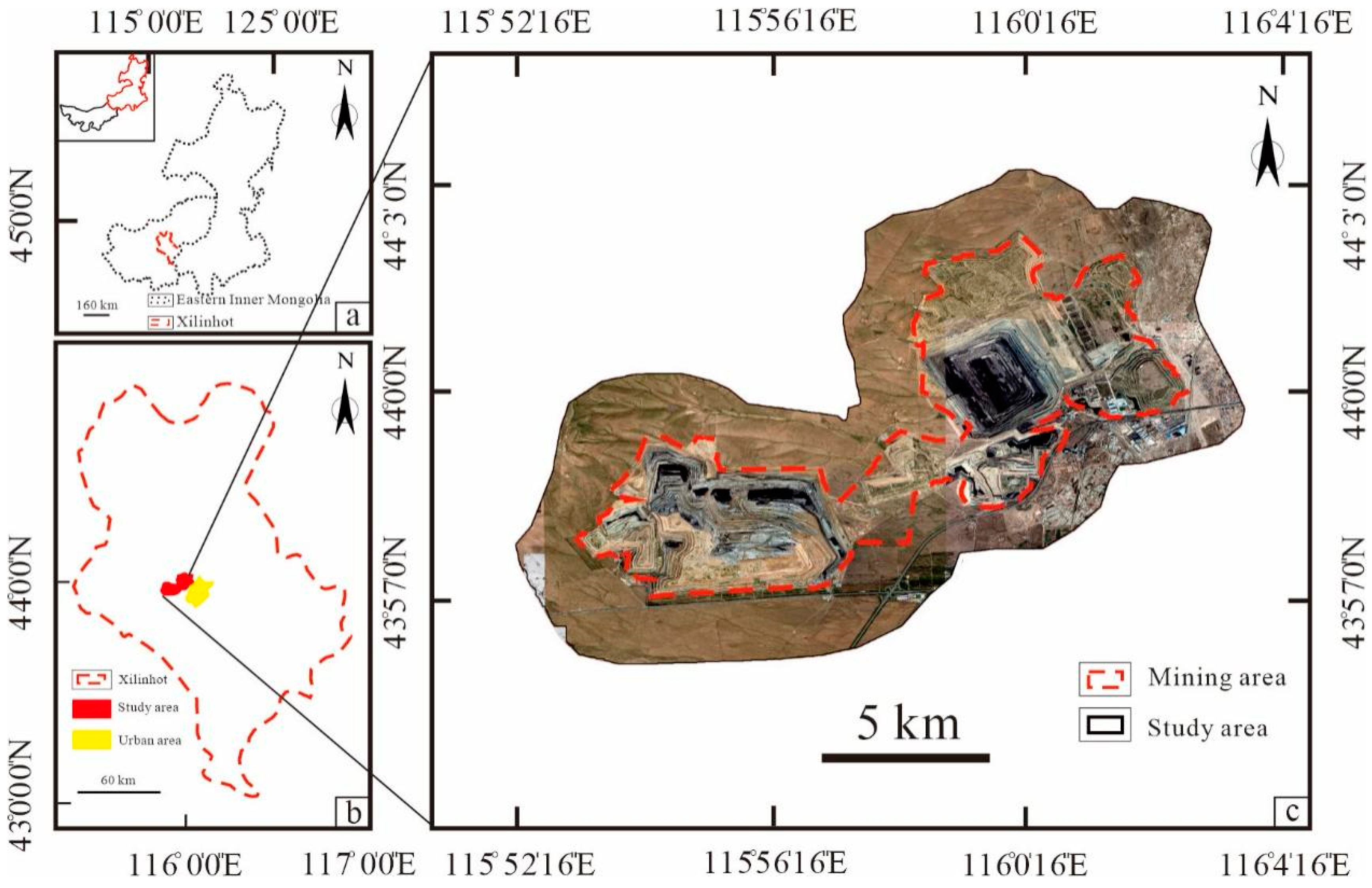
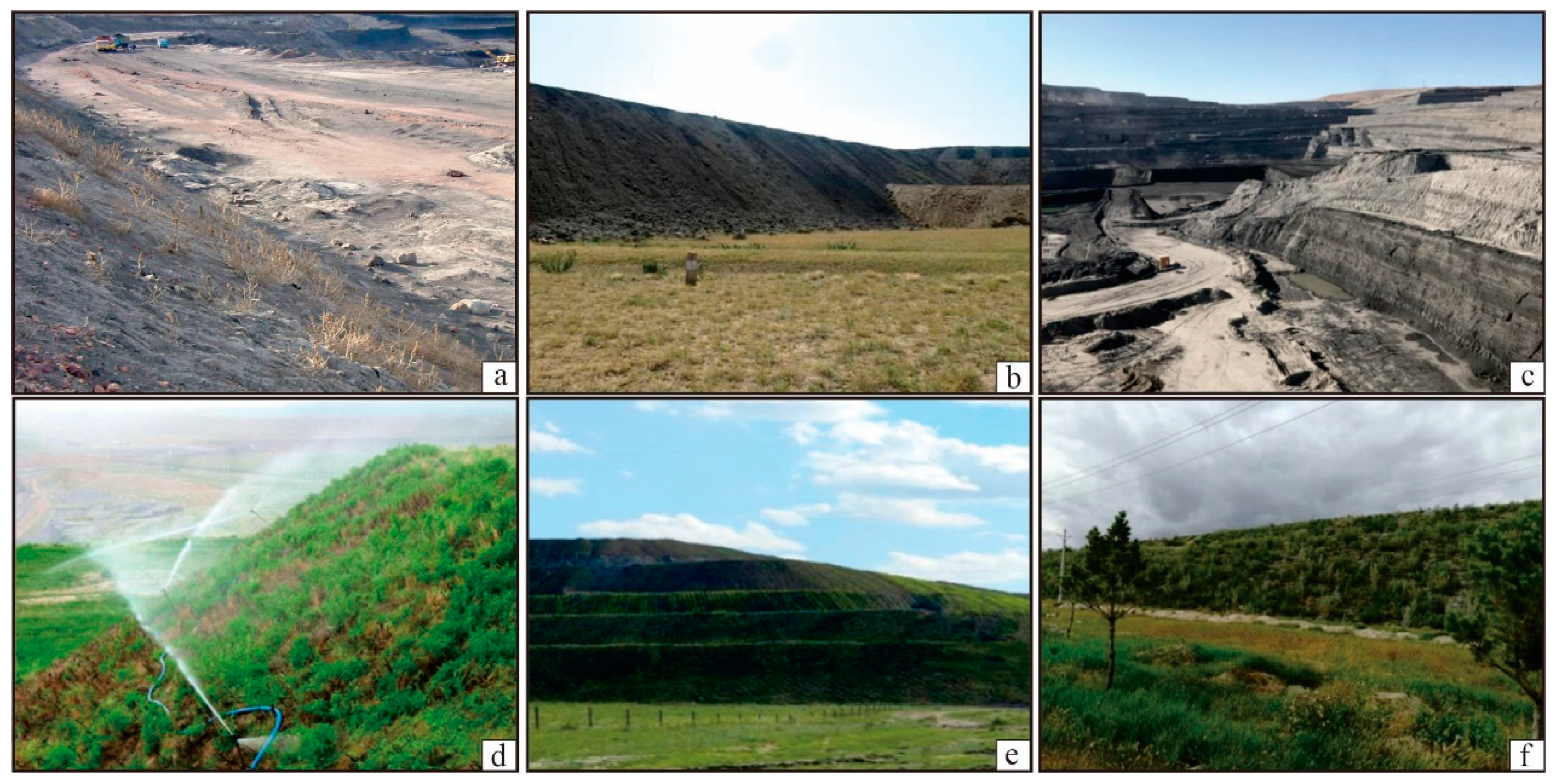
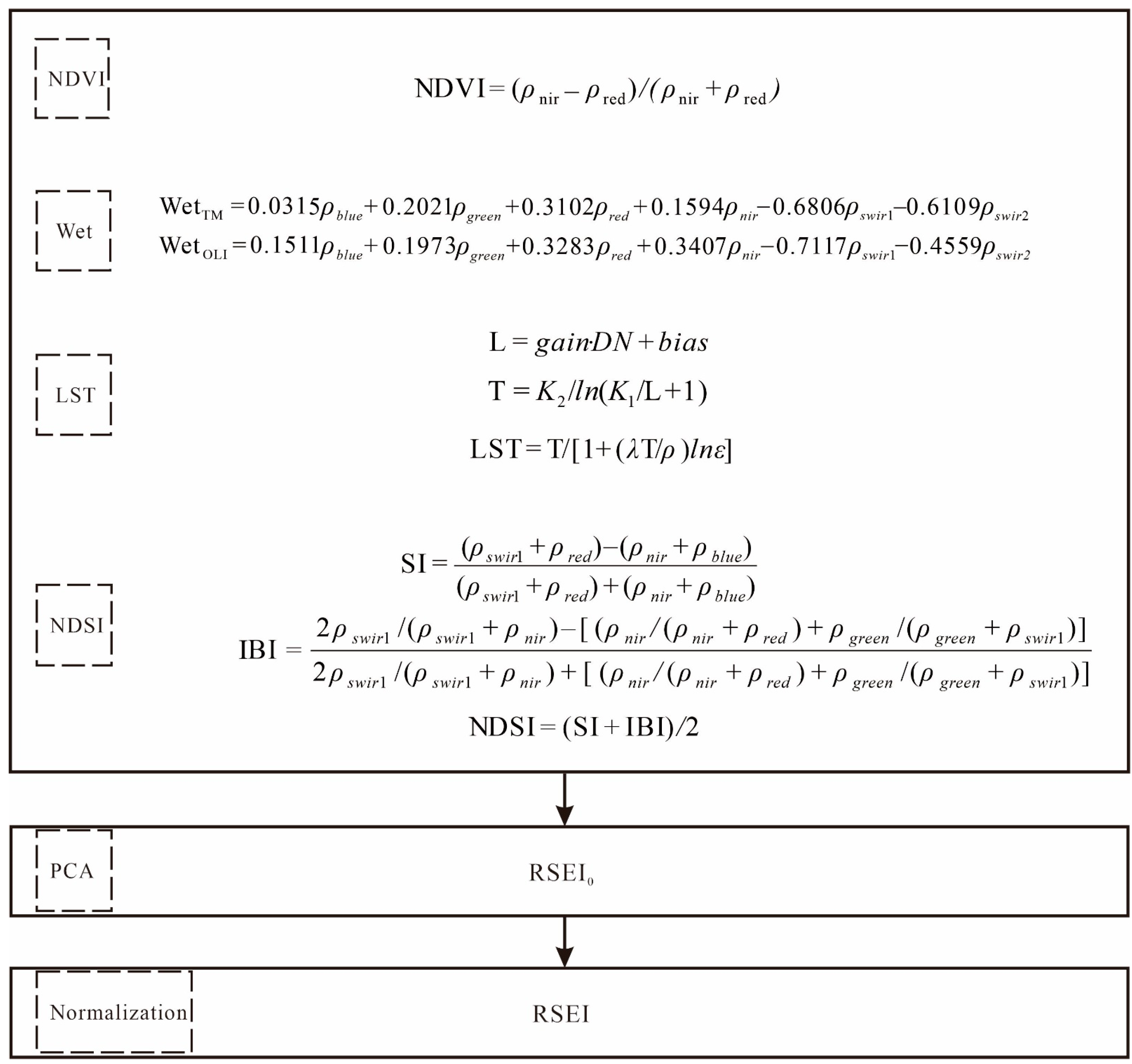

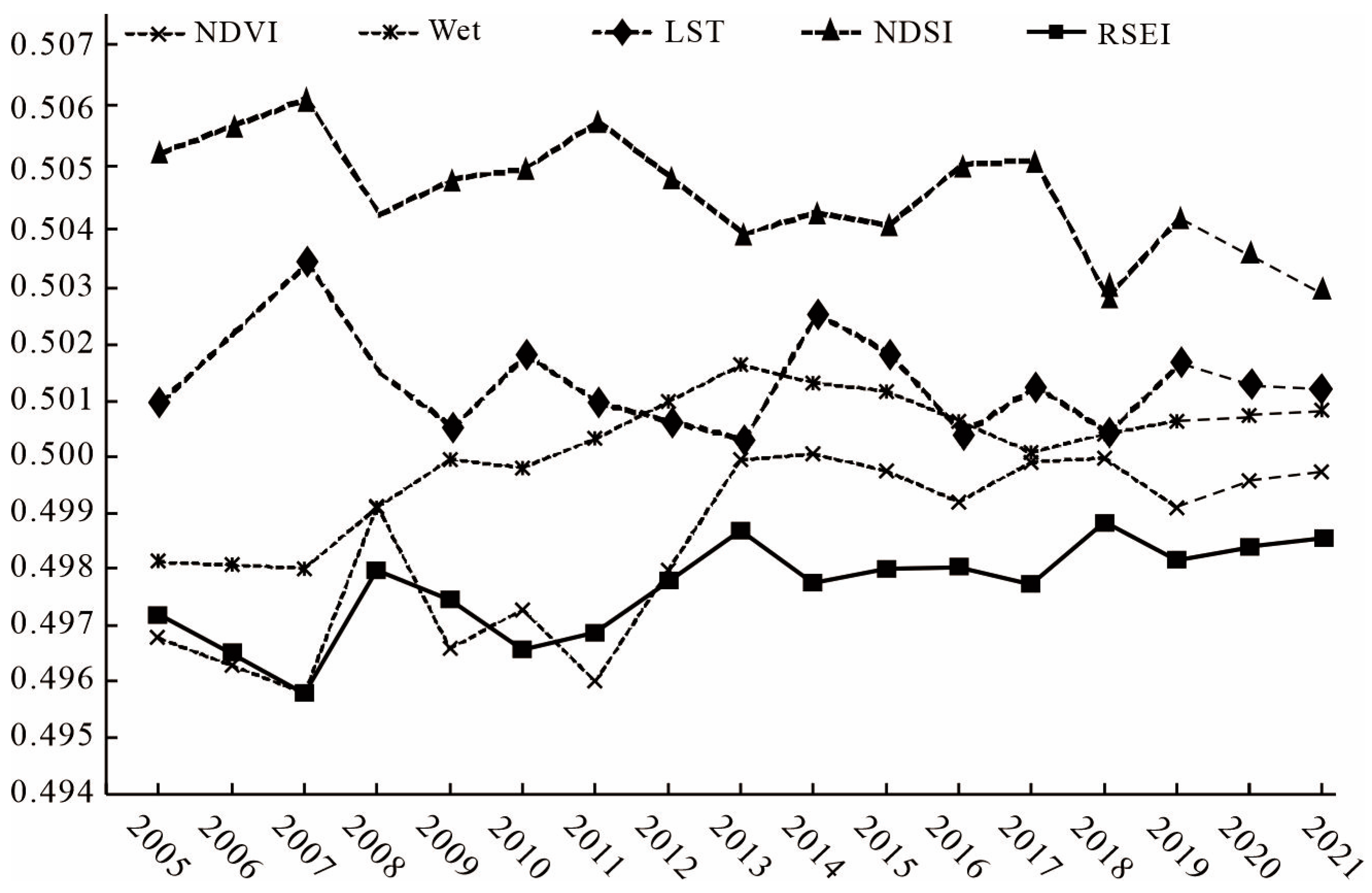

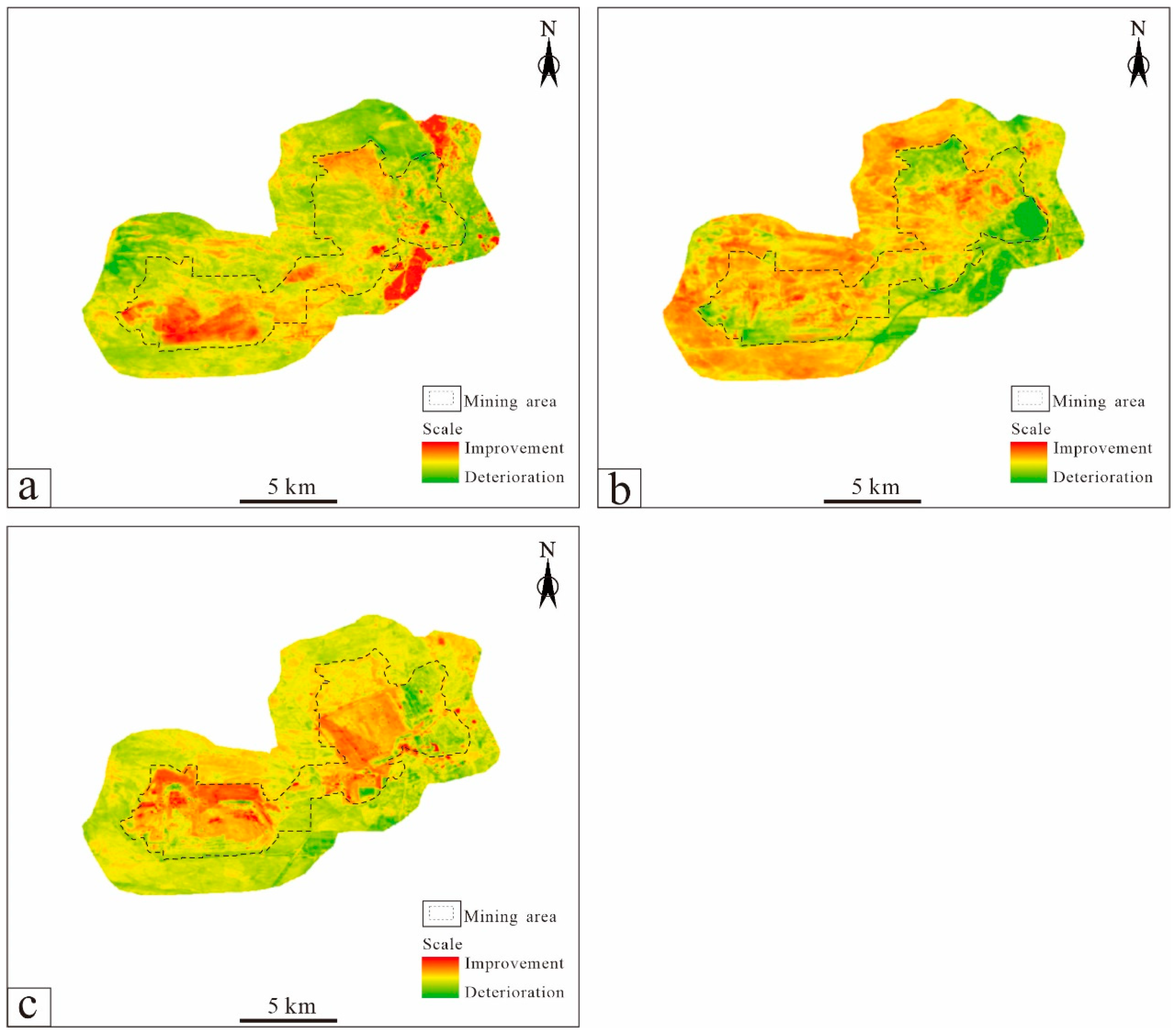

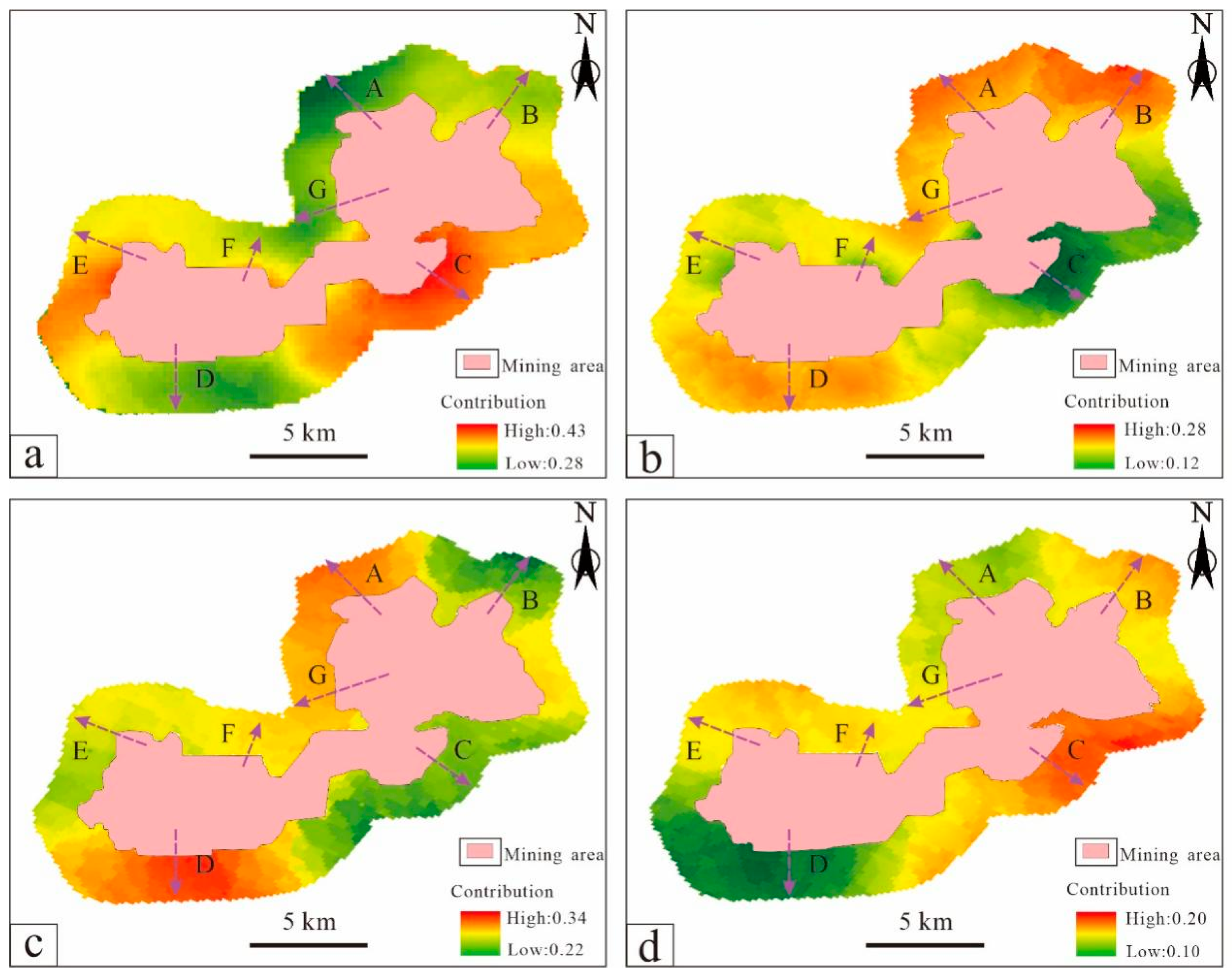
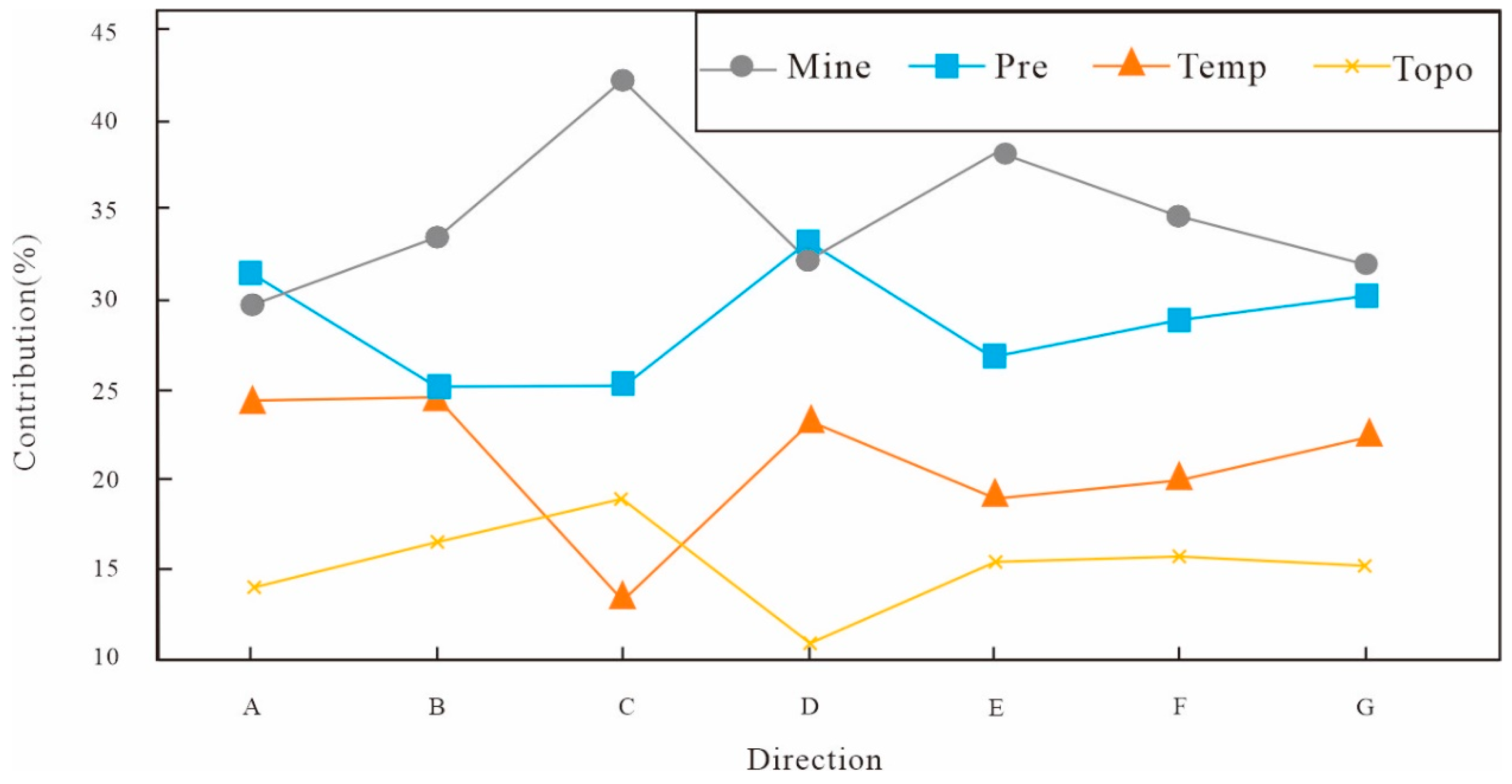
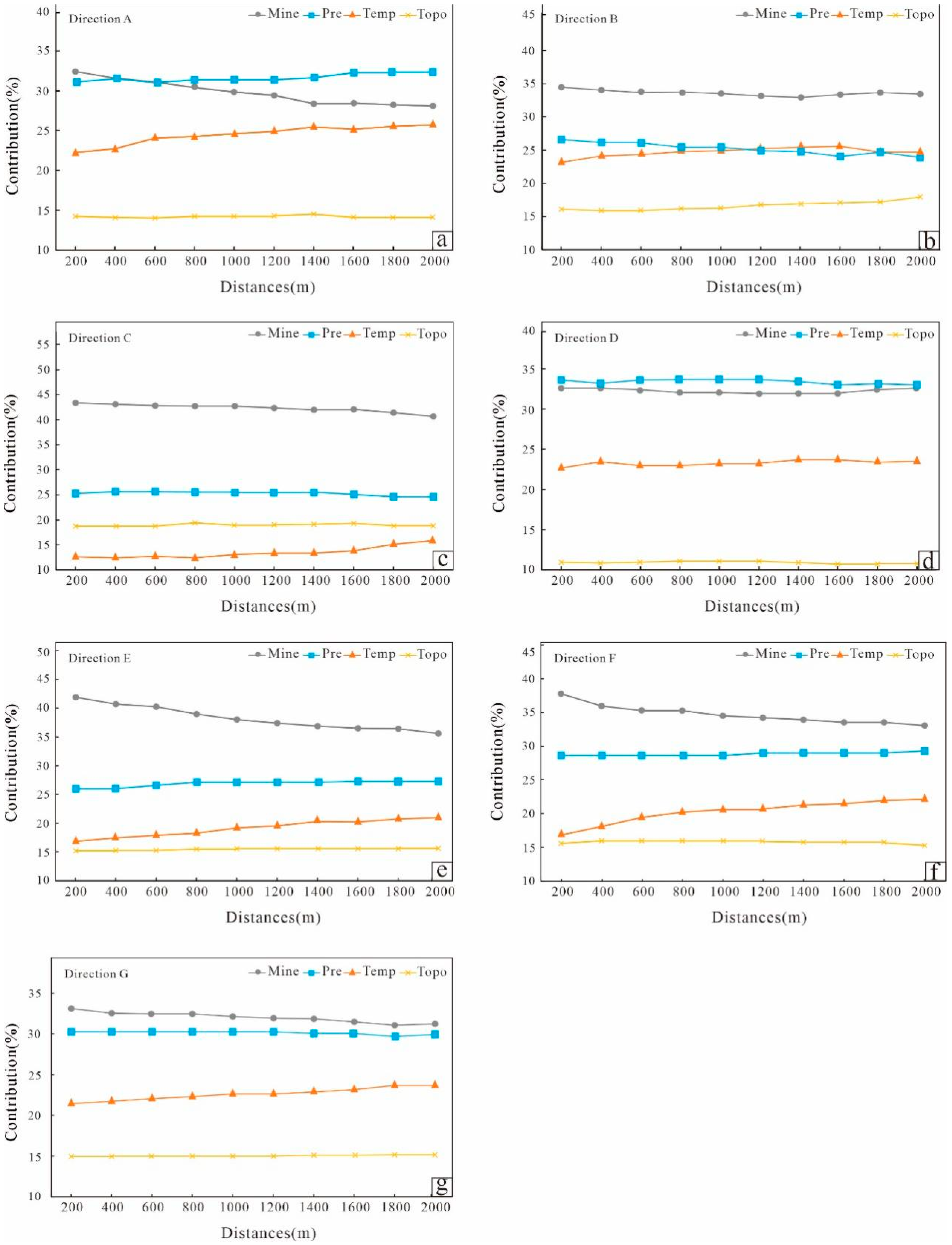
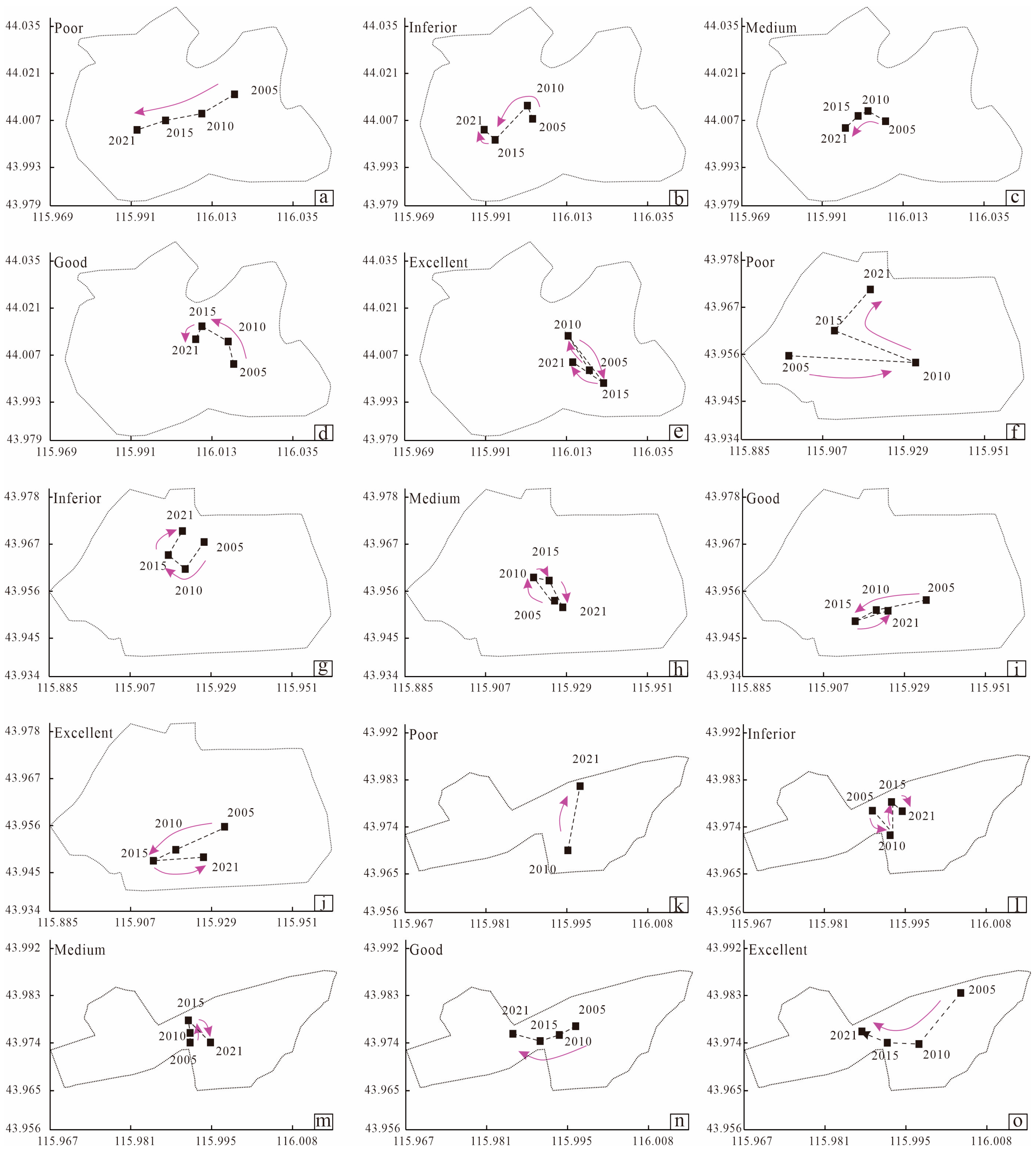
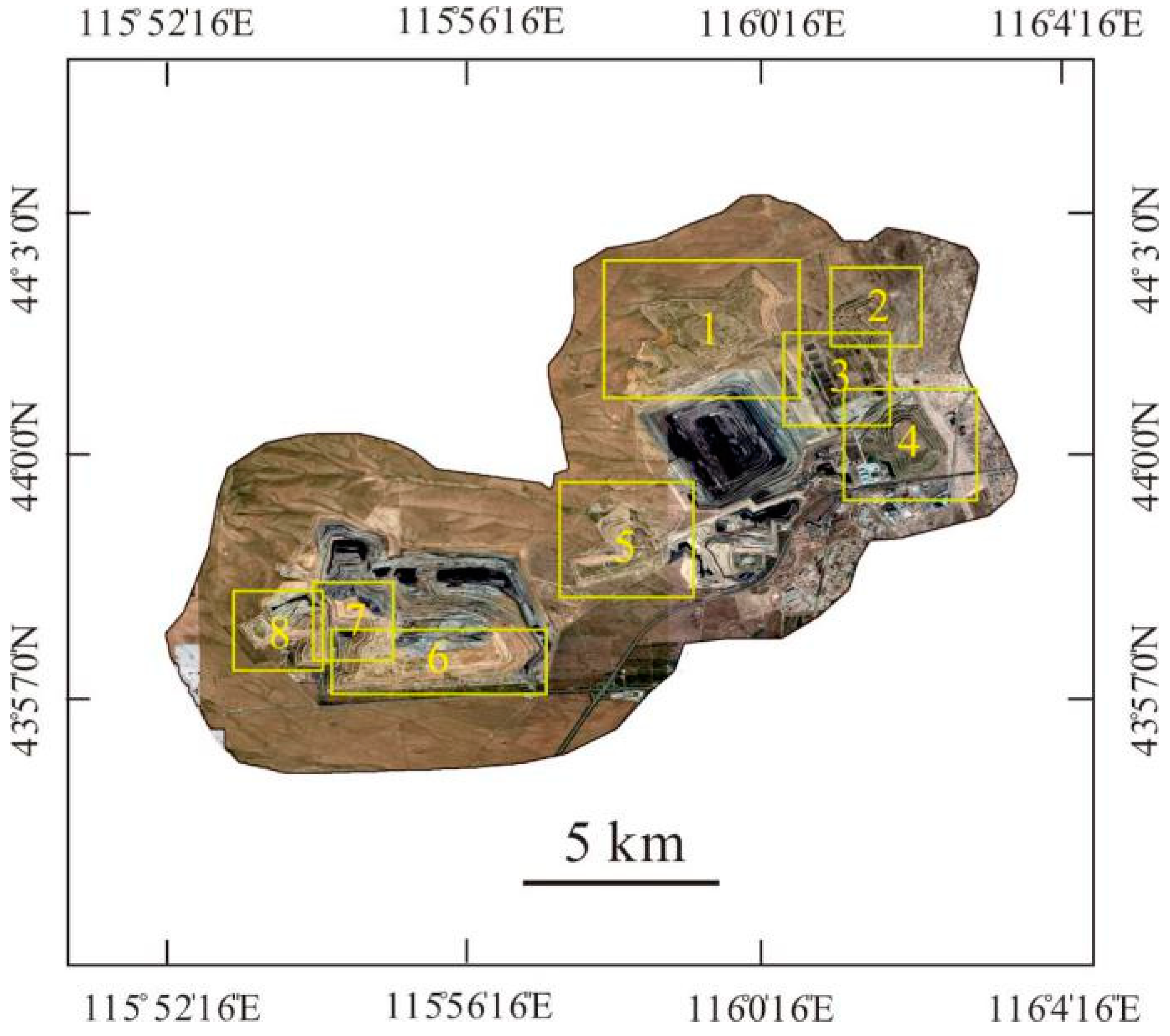
| RSEI Grade | 2005 | 2010 | 2015 | 2021 |
|---|---|---|---|---|
| Poor | 1.50% | 3.71% | 0.30% | 1.46% |
| Inferior | 24.96% | 17.89% | 31.95% | 26.59% |
| Medium | 52.58% | 61.63% | 44.16% | 48.02% |
| Good | 17.07% | 13.05% | 17.77% | 18.15% |
| Excellent | 3.89% | 3.72% | 5.82% | 5.78% |
| Driving Factor | Annual Average Contribution (%) | |||
|---|---|---|---|---|
| 2005 | 2010 | 2015 | 2021 | |
| Mining activity | 34.61 | 34.72 | 34.50 | 34.09 |
| Temperature | 22.03 | 21.97 | 22.06 | 22.16 |
| Precipitation | 27.49 | 27.42 | 27.71 | 27.73 |
| Topography | 15.87 | 15.89 | 15.73 | 16.02 |
Disclaimer/Publisher’s Note: The statements, opinions and data contained in all publications are solely those of the individual author(s) and contributor(s) and not of MDPI and/or the editor(s). MDPI and/or the editor(s) disclaim responsibility for any injury to people or property resulting from any ideas, methods, instructions or products referred to in the content. |
© 2023 by the authors. Licensee MDPI, Basel, Switzerland. This article is an open access article distributed under the terms and conditions of the Creative Commons Attribution (CC BY) license (https://creativecommons.org/licenses/by/4.0/).
Share and Cite
Chang, M.; Meng, S.; Zhang, Z.; Wang, R.; Yin, C.; Zhao, Y.; Zhou, Y. Analysis of Eco-Environmental Quality and Driving Forces in Opencast Coal Mining Area Based on GWANN Model: A Case Study in Shengli Coalfield, China. Sustainability 2023, 15, 10656. https://doi.org/10.3390/su151310656
Chang M, Meng S, Zhang Z, Wang R, Yin C, Zhao Y, Zhou Y. Analysis of Eco-Environmental Quality and Driving Forces in Opencast Coal Mining Area Based on GWANN Model: A Case Study in Shengli Coalfield, China. Sustainability. 2023; 15(13):10656. https://doi.org/10.3390/su151310656
Chicago/Turabian StyleChang, Ming, Shuying Meng, Zifan Zhang, Ruiguo Wang, Chao Yin, Yuxia Zhao, and Yi Zhou. 2023. "Analysis of Eco-Environmental Quality and Driving Forces in Opencast Coal Mining Area Based on GWANN Model: A Case Study in Shengli Coalfield, China" Sustainability 15, no. 13: 10656. https://doi.org/10.3390/su151310656
APA StyleChang, M., Meng, S., Zhang, Z., Wang, R., Yin, C., Zhao, Y., & Zhou, Y. (2023). Analysis of Eco-Environmental Quality and Driving Forces in Opencast Coal Mining Area Based on GWANN Model: A Case Study in Shengli Coalfield, China. Sustainability, 15(13), 10656. https://doi.org/10.3390/su151310656





